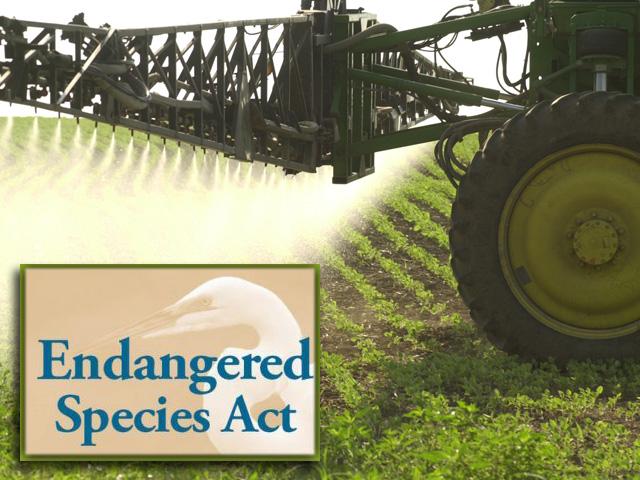EPA Lays Out ESA Roadmap for Pesticides
EPA Announces Plans for a New Approach to Endangered Species Act
WASHINGTON (DTN) -- The Environmental Protection Agency announced a series of steps Wednesday that EPA intends to take to comply with the Endangered Species Act when it comes to pesticide use.
In a speech to the National Association of State Departments of Agriculture, EPA Assistant Administrator Michal Freedhoff outlined how EPA will implement approaches for working with farm organizations and other federal agencies to protect endangered species.
Freedhoff noted that when registering pesticides under the Federal Insecticide, Fungicide, and Rodenticide Act (FIFRA), EPA must also comply with the Endangered Species Act (ESA) to ensure pesticides do not harm endangered species or their critical habitats. She pointed out that "this has resulted in considerable litigation against the agency, creating uncertainty for farmers and other pesticide users, unnecessary expenses and inefficiencies for EPA, and delays in the protection of endangered species," she said.
Freedhoff told the state agriculture officials that in April 2022, EPA released its ESA Workplan, which establishes strategies and actions to adopt those protections while ensuring farmers, public health authorities, and others have access to pesticides. In addition to other actions, EPA proposed a vulnerable species pilot and draft herbicide strategy in 2023. Stakeholders have expressed concerns related to the implementation ability of these strategies and urged EPA to make needed adjustments before finalizing the approaches, she added.
Freedhoff said EPA plans to address key concerns, expand its partnership with the Agriculture Department and seek additional stakeholder engagement in the coming months.
Responding to EPA's announcement, Alan Meadows, a Tennessee farmer and director for the American Soybean Association, said soybean growers are pleased EPA is hearing stakeholder concerns and responding to them.
P[L1] D[0x0] M[300x250] OOP[F] ADUNIT[] T[]
"ASA and other groups have raised significant concerns with the maps EPA has used for its Endangered Species Act pesticide proposals, as well as the lack of compliance options available to farmers," Meadows said. "Today's announcement should advance solutions to those challenges. While we do appreciate progress on these matters, it's important to remember there are other issues of concern to growers that we hope will be addressed within these ESA proposals, especially the cost of compliance and the lack of a science-based risk assessment process. The ESA proposals, while greatly improved by this announcement, still stand to put enormous financial burden on U.S. farmers without evidence to demonstrate these new restrictions are needed to help species. We look forward to working with EPA to develop solutions to these remaining challenges."
Freedhoff said EPA will not implement the Vulnerable Species Pilot protections, an effort to protect species that are particularly vulnerable to pesticides, until a more refined map of its habitat is developed. She said EPA will work with the U.S. Fish and Wildlife Service (FWS), USDA, the University of Georgia, and other stakeholders to develop maps that better reflect where these species live and where protections from pesticides are needed. In April, EPA plans to hold a workshop to facilitate and prioritize the development of these maps, and EPA will also develop guidelines that the public can use to develop and submit refined maps for hundreds of other endangered species.
Freedhoff noted that EPA signed a memorandum of understanding with the Agriculture Department's Natural Resources Conservation Service describing how EPA can include NRCS conservation practices on pesticide labels as one way growers who voluntarily perform those practices can use them to help fulfill pesticide label requirements.
Freedhoff also said, "Currently, if EPA needs to add new mitigations to pesticide labels, the agency must update hundreds or thousands of paper labels every time the menu of mitigation options is expanded -- a process that can take years." She said EPA will launch its first online mitigation menu that will allow the agency to quickly add new mitigation measures options, "thus ensuring that growers can use those new options promptly."
Regarding the MOU, Robert Bonnie, USDA undersecretary for farm production and conservation, said, "Farmers who use strong conservation practices developed by NRCS should be given credit for all of the benefits these practices provide, including reducing the off-site movement of pesticides. NRCS's programs remain entirely voluntary, and producers will not need NRCS approval. Collaboration between USDA and EPA through efforts such as this MOU and additional stakeholder conversations will help to keep safe, effective pest management tools in farmers' hands."
Finally, Freedhoff said EPA is working with stakeholders to determine how to use "offsets" when avoiding or minimizing pesticide exposure to an endangered species is impossible or impractical. In those situations, she said, it may be possible to offset the impact to the species through activities like funding habitat restoration for the species, contributing to a captive rearing project at a zoo for the species, or other steps to conserve the species. EPA, other federal agencies, and stakeholders are participating in a workshop later this month to discuss how to bring offsets into EPA's ESA-FIFRA work.
"This initiative should give pesticide registrants and users more flexibility to meet label requirements to protect endangered species, while directly contributing to recovering those species," she concluded.
EPA --Protecting endangered species from pesticides: https://www.epa.gov/…
EPA's workplan and progress for protecting endangered species: https://www.epa.gov/…
EPA's Vulnerable Species Pilot Project: https://www.epa.gov/…
DTN Ag Policy Editor Chris Clayton contributed to this report.
Jerry Hagstrom can be reached at jhagstrom@nationaljournal.com
Follow him on X, formerly known as Twitter, @hagstromreport
(c) Copyright 2024 DTN, LLC. All rights reserved.






